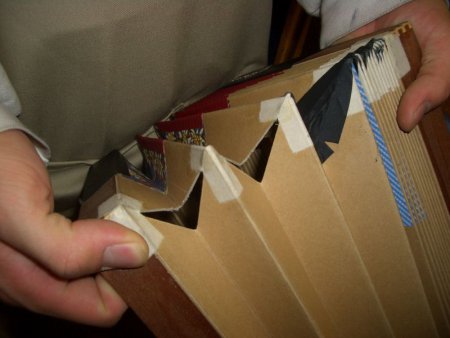bellows conjecture

image source wikipedia: unfinished Accordion bellows
A remarkable mathematical conjecture (proven 1995 by Sabitov) is that there exists no rigid bellows. This means if you have a closed volume which is formed by (triangle shaped) “plates” and if you deform it then the volume stays always constant (i.e. if it would have been a bellows then you couldnt press air out of it). This is why accordions need some elastic fabric in order to allow for deformation. May be also a useful knowledge for architecture, since it means that if you press a (closed) house on one side it would bulb on some other side.
The workshop Rigidity and polyhedral combinatorics is discussing related problems.
November 25th, 2018 at 1:50 pm
Nov. 25, 2018
Ms. Biruta KRESLING (German architect, designer and scientist living in Paris:
In 1992 a student of mine at the ARTS DECORATIFS in Paris found a pattern that is obtained by “twist buckling”. During 16 years I improved the pattern, and am able now to provoke the pattern spontaneously (at least three modes: 1,2,3…) in less one second.
I discoverd that this nearly stress free folding pattern exists in the “bellows” of Achaerontia atropos”, a giant hawkmoth that visits bee hives, even in Britain (!) – thanks to L.T. Wasserthal (German zoologist).
The pattern is named after me “Kresling Pattern” – “Kresling origami”- “Kresling Tower” and so on.
See: Biruta Kresling: Natural twist buckling in shells: from the hawkmoth’s bellows to the deployable “Kresling-pattern” and cylindrical “Miura-ori” (published in 2008)
A first technological application is proposed by Wilson, Pellegrino et al.(CALTECH, Pasadena and Northrop Gumman) for a foldable sunshield of the IXO Space Telescop, to be launched in 2028 (?)
See:Wilson, L., Pellegrino, S. and Danner, R. (2013), Origami inspired concepts for space telescopes, 54nd AIAA/ASME/ASCE/AHS/ASC Structures, Structural Dynamics, and Materials Conference 9 April 2013, Boston, MA,
Since 2008 at least 30 applications and research topics are based upon the “Kresling Pattern”
Best regards Biruta Kresling
November 30th, 2018 at 4:52 pm
Hello Ms. Kresling
Thanks for the very interesting comment. In fact, I didn’t really know about the “Kresling-pattern” which you explained above and whose production can be nicely seen e.g. in this video on pbs.org: https://www.pbs.org/video/nova-our-origami-world/ (via thekidshouldseethis.com). That is I very much think I had previously seen the pattern, but I didn’t know anything about its history. However I would like to add that I haven’t found the time to think much about this and other folding patterns, that is I think it is very likely that the Kresling pattern is related to a specific mathematical system (see also below about Miura-Ori).
In case you haven’t seen those posts yet- concerning the logarithmic spiral as mentioned in the video: there is a randform post, where Tim and me interprete Max Bill’s nested polygons as a prototype for a “discrete” logarithmic spiral (Mathematicians call something discrete if it is not smooth, i.e. something is “discrete” if it constists of distinguishableble parts, like plates (which may be connected by hinges etc.), in german : “Plättchen”, in math speak: “planar faces”. In contrast to this “smooth” means that something consists rather of a continuum of “parts”, where you don’t see the boundary of each part.)
Your article seems only available on academia.edu, so I haven’t looked it yet, because I am not a member of academia.edu. But I had a look at the Wilson,Pellegrino,Danner article, which is currently available here.
The (plain) Miura-Ori has also been discussed in this randform post. In particular in this post it is again described that the Miura-Ori can be seen as a “discrete system” which is connected to a rather well-known smooth system (Tim explaines the details to John Baez in a comment below the post), moreover it is described that we got the suspicion that the Miura-Ori may have eventually been already known to Joseph Albers.